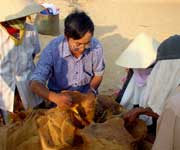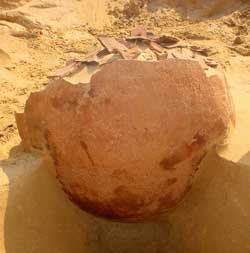The excavation of the Gò Quê burial site reveals many intriguing aspects of the Sa Huỳnh culture: In addition to jars, they also buried the dead in earth graves.
 |
|
Archaeologists are excavating (Photo: CAND) |
The Sa Huỳnh culture is well-known and relatively familiar, having been discovered nearly 100 years ago. However, recent excavations have yielded a wealth of artifacts and intriguing new findings. Some of these discoveries were revealed during the excavation of the Gò Quê burial site earlier this year.
The first remarkable story is the discovery of this burial site. If it weren’t for the land clearance for a shipbuilding factory in the Dung Quất industrial zone, the residents of Sơn Trà fishing village in Bình Đông commune, Bình Sơn district, Quảng Ngãi province would never have imagined that their village harbored a relic over 2,000 years old.
This burial site is nestled within a mound, with graves dug up to 4 meters deep from the mound’s peak, a depth unattainable by any civilian construction.
Typically, burial sites are dug shallow, around 50 cm deep. So why did the Sa Huỳnh people here take the trouble to dig such deep graves for the deceased? The answer will only be revealed once the excavation site is completed and the original landscape reconstructed. It turns out that the mound here was not originally as high as it is now.
In ancient times, graves were buried at depths similar to other regions. However, after over 2,000 years, a large mound has completely covered the burial site. The reason for this is… the wind. The burial area is subject to strong winds funneling in from the bay, causing sand dunes to shift across a wide area, which now completely envelops the ancient graves.
The second remarkable story lies in the burial practices of the ancients. For nearly a century of discovering and studying the Sa Huỳnh culture, scholars have associated the Sa Huỳnh people with the custom of burying the dead in jars. There are various opinions regarding the use of these jars.
 |
|
A jar burial (Photo: CAND) |
For example, some believe that the entire body was placed inside the jar and then sealed, while others think the body was cremated first, and only the ashes were placed in the jar (a form of cremation). Some scholars have even hypothesized that the jars contained no bodies at all but were merely a symbolic burial. Because the Sa Huỳnh were closely connected to the sea, their livelihoods depended on the coastal currents, and when they died, they returned their bodies to the ocean, only to bury jars and grave goods in the sand as a tribute to the deceased upon reaching the shore…
Although many opinions are still debated, it seems there is a consensus: the ceramic jars are an inseparable part of the burial customs of the Sa Huỳnh people. In fact, in some areas like the coastal region of Sa Huỳnh in Đức Phổ district, Quảng Ngãi, when first discovered in the early 20th century, there were so many jars that the French archaeologist H. Parmentier had no other term to describe it than “Sa Huỳnh jar cemetery.”
However, recent findings suggest otherwise, particularly at the Gò Quê burial site. In addition to jars, they also buried the dead in earth graves. The deceased were laid down, pottery was broken, and even entire jars were smashed to scatter the pieces around the body. The ratio of earth graves to jar graves here is 13 earth graves to 18 jar graves, indicating that the ancients practiced two forms of burial, with similar grave goods and pottery shards.
Not many Sa Huỳnh burial sites exhibit both burial methods. This also contributes to refuting the hypothesis that the Sa Huỳnh people discarded their dead bodies into the sea. In reality, they buried their loved ones in jars (recent scientific experiments have shown that jars can indeed accommodate a body if it is positioned in a fetal position) and also buried them laid down (the length of the grave and the arrangement of the pottery shards correspond with the height of an adult).
The third remarkable story concerns the grave goods at the Gò Quê burial site. Archaeologists were astonished to find a series of bronze artifacts from the Đông Sơn culture here, creating the impression that they were excavating an authentic Đông Sơn cultural site, unmistakably distinct. These included: six rectangular bronze axes with geometric patterns, a flared axe with a fish-tail-shaped throat, a leaf-shaped spearhead, a T-shaped handguard dagger, and a breastplate with spiral patterns.
This evidence demonstrates that, at that time, the ancestors of the Vietnamese and Cham ethnic groups had interactions and traded goods. Previously, based on available documents, French archaeologist M. Colani believed that Đông Sơn bronze artifacts were only traded as far as Cương Hà and Cổ Giang (Quảng Bình). Now, it appears that Đông Sơn bronze artifacts reached even further, at least into northern Quảng Ngãi, the heart of the Sa Huỳnh culture.
The fourth remarkable story: for the first time, archaeologists found a unique artifact. It is a sword with a blade made of iron but a hilt made of bronze. Artifacts made from both metals are rarely discovered in our country and are considered a type of “copper-iron alloy.” The sword is exquisitely crafted, particularly the bronze hilt, which consists of multiple tubes and rings assembled around a wooden core.
PGS-TS Trịnh Sinh




















































